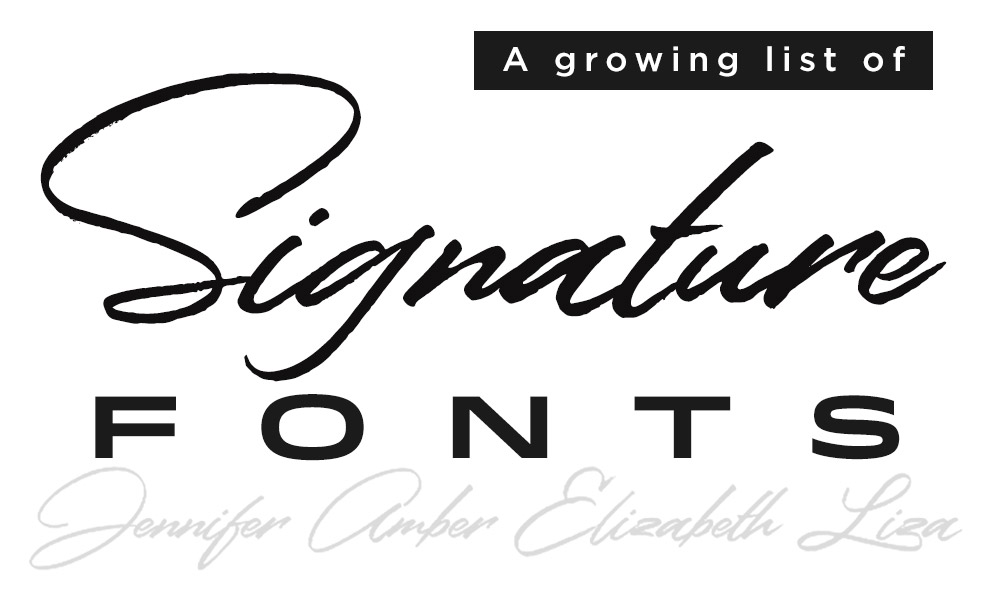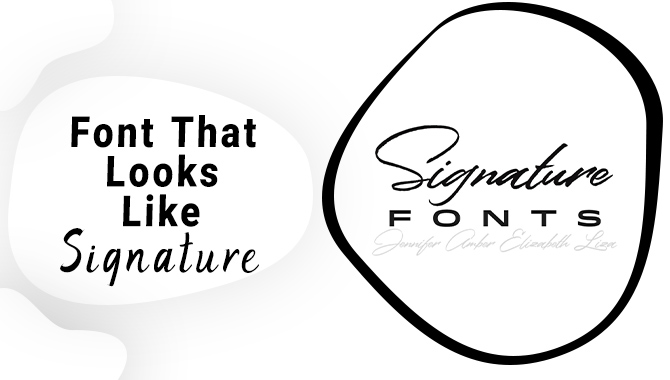What Makes a Font Look Like a Signature?
A font that looks like a signature is characterized by its unique blend of fluidity, uniqueness, and imperfections. These traits contribute to a font’s authenticity and personal feel, making it an ideal choice for designers seeking to add a touch of humanity to their work. The fluidity of a signature font is often achieved through the use of connected letterforms, which mimic the natural flow of handwriting. This fluidity creates a sense of dynamism and energy, drawing the viewer’s eye through the text.
Uniqueness is another key characteristic of a signature font. Each letterform is carefully crafted to be distinct from others, with subtle variations in shape, size, and spacing. This uniqueness adds a level of sophistication and elegance to the font, making it perfect for use in high-end branding and marketing materials. Imperfections, such as slight irregularities in line width and texture, also play a crucial role in creating a font that looks like a signature. These imperfections add a touch of humanity to the font, making it feel more organic and less mechanical.
When used effectively, a font that looks like a signature can add a level of emotional resonance to a design. It can convey a sense of personality and character, making the viewer feel more connected to the message being communicated. Whether used in a logo, headline, or body text, a signature font has the power to elevate a design and make it truly unforgettable. By incorporating a font that looks like a signature into their work, designers can add a touch of authenticity and humanity, creating a deeper connection with their audience.
Top Picks for Signature-Style Fonts
When it comes to selecting a font that looks like a signature, there are many options to choose from. Here are some top picks for signature-style fonts that are sure to add a personal touch to your designs. Pacifico, a beautiful script font with a relaxed, casual feel, is perfect for use in logos, headings, and body text. Its unique blend of fluidity and elegance makes it an ideal choice for designers seeking to add a touch of sophistication to their work.
Great Vibes, another popular signature-style font, is known for its energetic and lively feel. Its bold, cursive letterforms are perfect for use in headlines and titles, and its unique imperfections add a touch of humanity to the font. Dancing Script, a elegant and refined script font, is perfect for use in formal designs, such as wedding invitations and luxury branding materials. Its beautiful flourishes and swashes add a touch of sophistication and elegance to the font.
These fonts, and many others like them, are perfect for designers seeking to add a personal touch to their work. By incorporating a font that looks like a signature into their designs, designers can create a deeper connection with their audience and convey a sense of personality and character. Whether used in a logo, headline, or body text, a signature font has the power to elevate a design and make it truly unforgettable.
How to Choose the Perfect Signature Font for Your Design
Choosing the perfect signature font for your design can be a daunting task, especially with the numerous options available. However, by considering a few key factors, you can select a font that perfectly complements your design and adds a personal touch. First and foremost, consider the legibility of the font. A font that is difficult to read can be frustrating for the viewer and detract from the overall design. Look for a font with clear and distinct letterforms that are easy to read, even at small sizes.
Versatility is another important factor to consider when selecting a signature font. A font that can be used in a variety of contexts, such as logos, headings, and body text, can be a valuable asset to your design arsenal. Consider a font that has multiple weights and styles, such as bold, italic, and condensed, to provide flexibility in your design. Emotional resonance is also an important consideration when selecting a signature font. A font that evokes the right emotions and conveys the desired message can be a powerful tool in your design.
When selecting a signature font, it’s also important to consider the overall aesthetic you want to achieve. Do you want a font that is elegant and refined, or one that is bold and playful? Consider the tone and personality of your brand and choose a font that aligns with those qualities. By considering these factors and taking the time to select the perfect signature font, you can add a personal touch to your design and create a lasting impression on your audience.
Using Signature Fonts in Digital Design
Signature fonts can be a powerful tool in digital design, adding a personal touch and creating visual interest in a variety of applications. One of the most effective ways to use signature fonts is in logos and branding materials. A custom signature font can help to create a consistent visual identity and convey a brand’s personality and values. For example, a fashion brand might use a elegant and refined signature font to convey a sense of luxury and sophistication.
Signature fonts can also be used to add a personal touch to headings and titles. A bold and playful signature font can help to grab the viewer’s attention and draw them into the content. In addition, signature fonts can be used to create visual interest in body text, adding a touch of personality and whimsy to the design. However, it’s essential to use signature fonts judiciously, as overusing them can detract from the overall design.
Another effective way to use signature fonts is in digital advertising and marketing materials. A custom signature font can help to create a consistent visual identity and convey a brand’s message in a unique and compelling way. For example, a company might use a signature font in a social media campaign to create a sense of personality and authenticity. By incorporating signature fonts into digital design, designers can add a personal touch and create a lasting impression on their audience.
Creating a Custom Signature Font from Your Own Handwriting
Creating a custom signature font from your own handwriting can be a unique and creative way to add a personal touch to your designs. The process begins with scanning or photographing your handwriting, either from a piece of paper or a whiteboard. This will provide a digital version of your handwriting that can be used to create a font. Next, you will need to use font creation software, such as FontForge or Glyphs, to create a digital font from your handwriting.
The font creation software will allow you to refine the design of your font, including adjusting the letterforms, spacing, and kerning. This is an important step, as it will ensure that your font is legible and visually appealing. Once you have refined the design of your font, you can export it as a digital font file, such as a TrueType or OpenType file. This file can then be used in your designs, either in a graphics program or in a word processor.
Creating a custom signature font from your own handwriting can be a fun and rewarding experience, and it can add a unique and personal touch to your designs. Whether you are a designer, artist, or simply someone who wants to add a personal touch to your documents, creating a custom signature font is a great way to do so. With the right software and a little bit of creativity, you can create a custom signature font that reflects your personality and style.
Signature Fonts in Branding and Marketing
Signature fonts play a significant role in branding and marketing, as they can help create a consistent visual identity and convey a brand’s personality and values. A well-designed signature font can be used across various marketing materials, including logos, business cards, letterheads, and website design. This consistency helps to establish a strong brand identity and reinforces the brand’s message.
In addition to creating a consistent visual identity, signature fonts can also be used to convey a brand’s personality and values. For example, a luxury brand might use a elegant and refined signature font to convey a sense of sophistication and high-end quality. On the other hand, a fun and playful brand might use a bold and quirky signature font to convey a sense of humor and approachability.
Signature fonts can also be used to create a sense of authenticity and uniqueness in branding and marketing. A custom-designed signature font can help a brand stand out from its competitors and establish a unique visual identity. Furthermore, a signature font can be used to create a sense of continuity across different marketing channels, including social media, email marketing, and advertising.
Common Mistakes to Avoid When Using Signature Fonts
While signature fonts can add a personal touch to designs, there are common mistakes to avoid when using them. One of the most common mistakes is overusing signature fonts. While it can be tempting to use a signature font throughout a design, it’s essential to use them judiciously to avoid overwhelming the viewer. Instead, use signature fonts sparingly to add emphasis and create visual interest.
Another mistake to avoid is using signature fonts inappropriately. For example, using a formal signature font in a playful or casual design can look out of place. Similarly, using a bold and playful signature font in a formal or professional design can detract from the overall message. It’s essential to choose a signature font that aligns with the tone and personality of the design.
Neglecting to consider the legibility and readability of a signature font is another common mistake. While signature fonts can add a personal touch to designs, they can also be difficult to read if not designed carefully. It’s essential to choose a signature font that is clear and easy to read, even at small sizes. By avoiding these common mistakes, designers can effectively use signature fonts to add a personal touch to their designs.
Conclusion: Adding a Personal Touch with Signature Fonts
Signature fonts can add a personal touch to designs, making them more unique and memorable. By understanding the characteristics of a font that resembles a signature, including fluidity, uniqueness, and imperfections, designers can effectively use signature fonts to create a personal and authentic feel. From choosing the perfect signature font to creating a custom font from your own handwriting, there are many ways to incorporate signature fonts into digital design.
Whether used in logos, headings, or body text, signature fonts can add a touch of personality and whimsy to designs. By avoiding common mistakes, such as overusing signature fonts or neglecting to consider their legibility and readability, designers can effectively use signature fonts to create a consistent visual identity and convey a brand’s personality and values.
In conclusion, signature fonts are a powerful tool in digital design, offering a unique and personal way to add a touch of authenticity and personality to designs. By understanding the characteristics of signature fonts and how to effectively use them, designers can create designs that are truly memorable and impactful.







